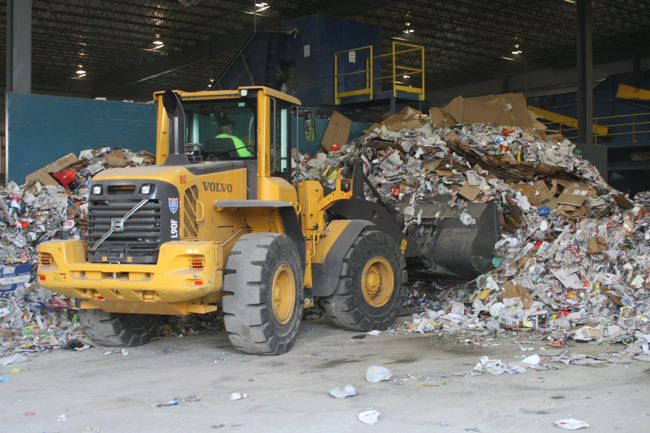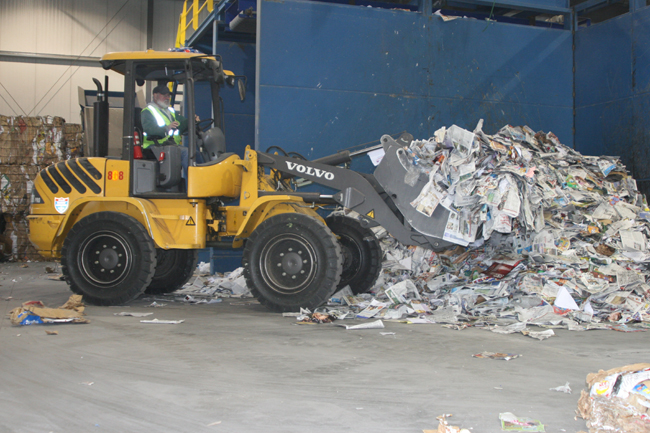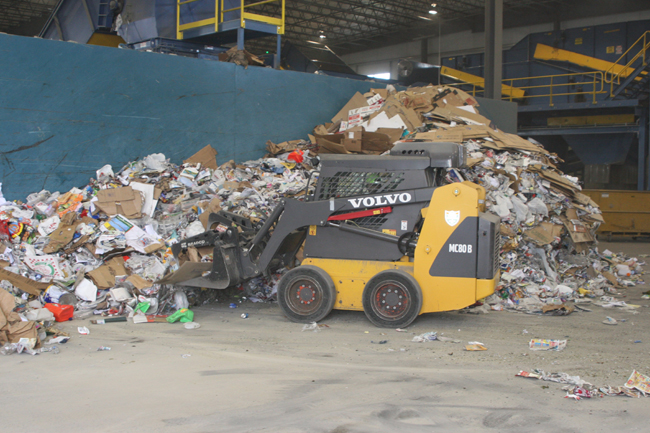Volvo Rolls Green at Recycling Center
Mauricio Tobon likes to talk about waste recycling. “If you recycle your Sunday newspaper every week for one year, you save three trees,” says Tobon, the recycling manager at the Material Recovery Facility (MRF), a recycling center run by Penn Waste Inc. in York, Pa.
“We went green with this new recycling facility,” Tobon continues. “There is only one landfill in York County. It feels good to be doing something that contributes to society as a whole and helps to save the environment.”

The new state-of-the-art facility is an unqualified success. In operation since February 2008, Penn Waste’s MRF recycles and sorts single-stream household waste — paper, cardboard, glass, metals and plastics. For about six years, the company has operated a commingled waste facility — which sorts metals, glass and plastics, but not paper or cardboard — on the same site as the MRF.
Today’s recycling technology enables waste recovery companies like Penn Waste to sort the paper and cardboard from the plastics, glass and metals. That way, homeowners need not separate the paper and cardboard from other recyclable waste.
More than 30 trucks per day bring waste material to the MRF in York. Working 20 hours per day, the facility processes approximately 4,000 tons of single-stream waste per month. Recently, the MRF began processing construction and demolition debris, and in one week produced 191 tons of recycled construction materials — sorted into wood, masonry, drywall, paper, cardboard and metal.
Workers and Machines
The recycling process calls for an interesting blend of workers and machines. When entering the MRF (which is the size of an indoor sports arena), visitors immediately notice a Volvo MC80B skid steer loader hustling to grab single-stream waste with its scrap grapple and feed the material onto a large conveyor.
“That Volvo skid steer is the backbone of this operation,” says Tobon. “That’s the machine that makes everything happen, because it feeds the unsorted waste to the in-feed conveyor. We really like the maneuverability of the Volvo skid-steer loaders. They can turn on a dime. And don’t let their small size fool you. Those little machines are powerful.”
At the MRF, Penn Waste operates two Volvo skid steer loaders. Each loader handles one 10-hour shift, and the working conditions are difficult. There’s considerable dust, and when the loader pushes up into a pile, the waste nearly covers the machine.
Supervisor Angelo Lopes says the Volvo skid steers have held up well under the long hours and difficult conditions. “We haven’t had any more problems than normal, and when we do have a problem we call Highway Equipment, our Volvo dealer. Their support is very good,” says Lopes.
Operator Bill Newbould says he really likes the Volvo skid steers. “I’ve run other skid steers and I like the Volvo best,” he says. “I like the maneuverability, and it’s very smooth and responsive. And the foot throttle is really nice. You can ease into it with that throttle.”
From the in-feed conveyor, the single-stream waste moves to an elevated conveyor that passes four workers who sort out plastic containers and bags by hand. Next, the material moves across screens where large disks rotate in the waste stream and sort out the cardboard. A second set of disks follows and sorts out paper, which falls back to the floor of the MRF. Plastic, metals and glass fall through to be processed at the nearby commingled waste facility.
As the paper falls to the MRF floor, it doesn’t take long to build up an 8- to 10-ft tall pile. When enough paper has piled up, a Volvo L30B Pro compact loader attacks the pile and pushes paper onto a 6-ft wide conveyor that takes it to a baler. “That compact loader really gets the job done,” says Newbould, who has run every machine in the MRF. “That little loader gets around very well, and can move into tight places easily.”
Tobon agrees. “That Volvo L30B is excellent for working in the kind of confined spaces that we have here,” he says. “And it has high clearance, which is good for working around recycled debris.”
Construction Debris
In another corner of the MRF, a Volvo EC160C excavator, fitted with a full grapple, picks up pieces of construction waste and places it on a conveyor. The conveyor elevates the material and places it onto a moving belt with 14 individual work stations. There, workers sort out wood, masonry, drywall, paper, cardboard and metal. “We figure that 50 to 70 percent of the waste in a construction dumpster is recyclable,” says Lauren Washburn, a communications specialist for Penn Waste.
Near the entrance, a Volvo L90F loader does two jobs, both of the cleanup variety. The big loader pushes construction waste from where trucks dump it into the larger pile. And it helps push single-stream household waste over closer to the Volvo skid loader. That way, the high-production skid loader has no travel distance at all. It can push into the pile, back up a bit, pivot and dump gradually onto the in-feed conveyor.
Newbould operates both the Volvo excavator and the larger loader, and he appreciates their abilities. “I like the EC160 excavator, he says. “It’s done everything we ask it to, and we’ve done some pretty heavy lifting with it. Not long ago, some guy knocked down a section of concrete barrier wall and we used the EC160 to pick it back up. It worked great. It’s operator-friendly and easy to control. I’ve extended the boom to reach as far as it could with a load and it handled the load just fine.
“The bigger Volvo loader is really user-friendly,” says Newbould. “You can sit there and control the bucket and the boom with just three fingers. The guy who figured that out really had his stuff together. You can run the machine with your right hand and steer with your left.
“And the boom has a suspension system on it so that if you drop the boom quickly, it will ease down,” says Newbould. “There’s a system that protects the hydraulic cylinders. Plus, every 15 minutes the radiator fan reverses itself and blows out dust, which around here is a real must. I wish the excavator had that feature. It keeps the loader’s radiator clean.”



Comments are closed here.